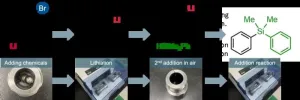(Press-News.org) Infection with Zika virus in pregnancy can lead to neurological disorders, fetal abnormalities and fetal death. Until now, how the virus manages to cross the placenta, which nurtures the developing fetus and forms a strong barrier against microbes and chemicals that could harm the fetus, has not been clear. Researchers at Baylor College of Medicine with collaborators at Pennsylvania State University report in Nature Communications a strategy Zika virus uses to covertly spread in placental cells, raising little alarm in the immune system.
“The Zika virus, which is transmitted by mosquitoes, triggered an epidemic in the Americas that began in 2015 and by 2018 had reached as many as 30 million cases,” said co-senior author Dr. Indira Mysorekar, E.I. Wagner Endowed, M.D., Chair Internal Medicine II, chief of basic and translational research and professor of medicine – infectious diseases at Baylor. “Understanding how Zika virus spreads through the human placenta and reaches the fetus is critical to prevent or control this devastating condition.”
The researchers discovered that Zika virus builds underground tunnels, a series of tiny tubes called tunneling nanotubes, that facilitate the transfer of viral particles to neighboring uninfected cells.
“We discovered that the formation of these tiny tunnels is driven exclusively by a Zika protein called NS1,” said first author Dr. Rafael T. Michita, postdoctoral research associate in the Mysorekar lab. “Exposure of placental cells to the NS1 protein of Zika virus triggers tunnel formation. As the tunnels develop and connect neighboring cells, a path opens for the virus to invade new cells.”
“Zika is the only virus in its family, which includes dengue and West Nile viruses among others, whose NS1 protein triggers the formation of tunnels in multiple cell types,” Michita said. “Other viruses unrelated to Zika, such as HIV, herpes, influenza A and SARS-CoV-2, the virus that causes COVID-19, also can induce tiny tunnels in cells they infect and use the tunnels to spread to uninfected cells. This is the first time that tunneling has been shown by Zika virus infection in placental cells.”
Interestingly, the tiny conduits provided a means to transport not only viral particles, but also RNA, proteins and mitochondria, a cell’s main source of energy, from infected to neighboring cells. “We propose that transporting mitochondria through the tunnels may provide an energetic boost to virus-infected cells to promote viral replication,” said co-author Long B. Tran, a graduate student in the Mysorekar lab.
“We also show that travelling through the tiny tunnels can potentially help Zika virus avoid the activation of large-scale antiviral responses, such as interferon lambda (IFN-lambda) defenses implemented by the placenta,” Michita said. “Mutant Zika viruses that do not make tiny tunnels induce robust antiviral IFN-lambda response that can potentially limit the spread of the virus.”
“Altogether, we show that Zika virus uses a tunneling strategy to covertly spread the infection in the placenta while hijacking mitochondria to augment its propagation and survival. We propose that this strategy also protects the virus from the immune response,” Mysorekar said. “These findings offer vital insights that could be used to develop therapeutic strategies targeted against this stealth transmission mode.”
Steven J. Bark and Deepak Kumar at Baylor College of Medicine and Shay A. Toner, Joyce Jose and co-senior author Anoop Narayanan at Pennsylvania State University are key members of the research team.
This work was supported in part by grants from NIH/NIAID (R01AI176505), NIH/NICHD (R01HD091218) and Pennsylvania State University startup funds. This project was also supported by the Cytometry and Cell Sorting Core at Baylor College of Medicine with funding from the CPRIT Core Facility Support Award CPRIT-RP180672 and the NIH (CA125123 and RR024574).
###
END
Stealth virus: Zika virus builds tunnels to covertly infect cells of the placenta
2025-02-21
ELSE PRESS RELEASES FROM THIS DATE:
The rising tide of sand mining: a growing threat to marine life
2025-02-21
In the delicate balancing act between human development and protecting the fragile natural world, sand is weighing down the scales on the human side.
A group of international scientists in this week’s journal One Earth are calling for balancing those scales to better identify the significant damage sand extraction across the world heaps upon marine biodiversity. The first step: acknowledging sand and gravel (discussed as sand in this publication) – the world’s most extracted solid materials by mass – are a threat hiding in plain sight.
“Sand is a critical resource that shapes the built and ...
Contemporary patterns of end-of-life care among Medicare beneficiaries with advanced cancer
2025-02-21
About The Study: This study found persistent patterns of potentially aggressive care, but low uptake of supportive care, among Medicare decedents with advanced cancer. A multifaceted approach targeting patient-, physician-, and system-level factors associated with potentially aggressive care is imperative for improving quality of care at the end of life.
Corresponding Author: To contact the corresponding author, Youngmin Kwon, PhD, email youngmin.kwon@vumc.org.
To access the embargoed study: Visit our For The Media website at this link https://media.jamanetwork.com/
(doi:10.1001/jamahealthforum.2024.5436)
Editor’s Note: Please see the article ...
Digital screen time and nearsightedness
2025-02-21
About The Study: In this systematic review and dose-response meta-analysis, a daily 1-hour increment in digital screen time was associated with 21% higher odds of myopia (nearsightedness) and the dose-response pattern exhibited a sigmoidal shape, indicating a potential safety threshold of less than 1 hour per day of exposure, with an increase in odds up to 4 hours. These findings can offer guidance to clinicians and researchers regarding myopia risk.
Corresponding Author: To contact the corresponding author, Young Kook Kim, PhD, email md092@naver.com.
To access the embargoed study: Visit our For The Media website at this link https://media.jamanetwork.com/
(doi:10.1001/jamanetworkopen.2024.60026)
Editor’s ...
Postoperative weight loss after anti-obesity medications and revision risk after joint replacement
2025-02-21
About The Study: In this cohort study using a target trial emulation, a higher proportion of weight loss after initiating anti-obesity medications within 1 year was associated with a lower risk of 5-year and 10-year revision among patients with obesity undergoing joint replacement. These results suggest that anti-obesity medication use, with relatively safe and sustainable weight loss, may be an effective strategy for improving implant survivorship of hip and knee replacements in the obese population.
Corresponding Author: To ...
New ACS research finds low uptake of supportive care at the end-of-life for patients with advanced cancer
2025-02-21
Despite considerable efforts to improve the quality of end-of-life care in the United States, a new retrospective study led by American Cancer Society (ACS) researchers revealed that close to half of patients with advanced cancer received potentially aggressive care at the end-of-life at the expense of supportive care. The findings are out today in the Journal of the American Medical Association (JAMA) Health Forum.
“Even though clinicians and professional healthcare organizations have recommended early integration of supportive and ...
New frailty measurement tool could help identify vulnerable older adults in epic
2025-02-21
Investigators at Mass General Brigham have developed a tool that can identify older adults at increased risk of emergency healthcare needs, rehospitalization or death. The tool measured patient frailty, an aging-related syndrome, by integrating the health records of more than 500,000 individuals collected across multiple hospitals at Mass General Brigham. These findings, published in Journal of the American Geriatric Society, could help clinicians care for high-risk patients even without the availability of comprehensive primary care records.
“Frailty ...
Co-prescribed stimulants, opioids linked to higher opioid doses
2025-02-21
COLUMBUS, Ohio – The combination of prescribed central nervous system stimulants, such as drugs that relieve ADHD symptoms, with prescribed opioid medications is associated with a pattern of escalating opioid intake, a new study has found.
The analysis of health insurance claims data from almost 3 million U.S. patients investigated prescribed stimulants’ impact on prescription opioid use over 10 years, looking for origins of the so-called “twin epidemic” of combining the two classes of drugs, which can increase the risk for overdose deaths.
“Combining the two drugs is associated ...
What if we could revive waste carbon dioxide?
2025-02-21
As the severity of climate change and carbon emissions becomes a global concern, technologies to convert carbon dioxide (CO₂) into resources such as chemical fuels and compounds are urgently needed. Dr. Dahee Park’s research team from the Nano Materials Research Division at the Korea Institute of Materials Science (KIMS), has collaborated with Professor Jeong-Young Park’s team from the Department of Chemistry at KAIST to develop a catalyst technology that significantly enhances the efficiency of carbon dioxide (CO2) conversion.
Conventional ...
Mechanochemistry strikes again – A facile means for generating organolithium molecules
2025-02-21
Mechanochemistry using a ball mill demonstrates versatility for generating academically and industrially significant organolithium compounds.
Organolithium compounds, molecules containing a carbon–lithium bond, are excellent precursors for building new carbon–carbon and other carbon–heteroatom bonds. They are widely utilized in both academia and industry for their applications in polymer synthesis, pharmaceuticals, and general organic synthesis. A conventional method for generating organolithiums is done ...
Breakthrough in high-performance oxide-ion conductors using rubidium
2025-02-21
Rubidium could be the next key player in oxide-ion conductors. Researchers at Institute of Science Tokyo have discovered a rare rubidium (Rb)-containing oxide-ion conductor, Rb₅BiMo₄O₁₆, with exceptionally high conductivity. Identified through computational screening and experiments, its superior performance stems from low activation energy and structural features like large free volume and tetrahedral motion. Its stability under various conditions offers a promising direction for solid oxide fuel cells and clean energy technologies.
Oxide-ion ...




